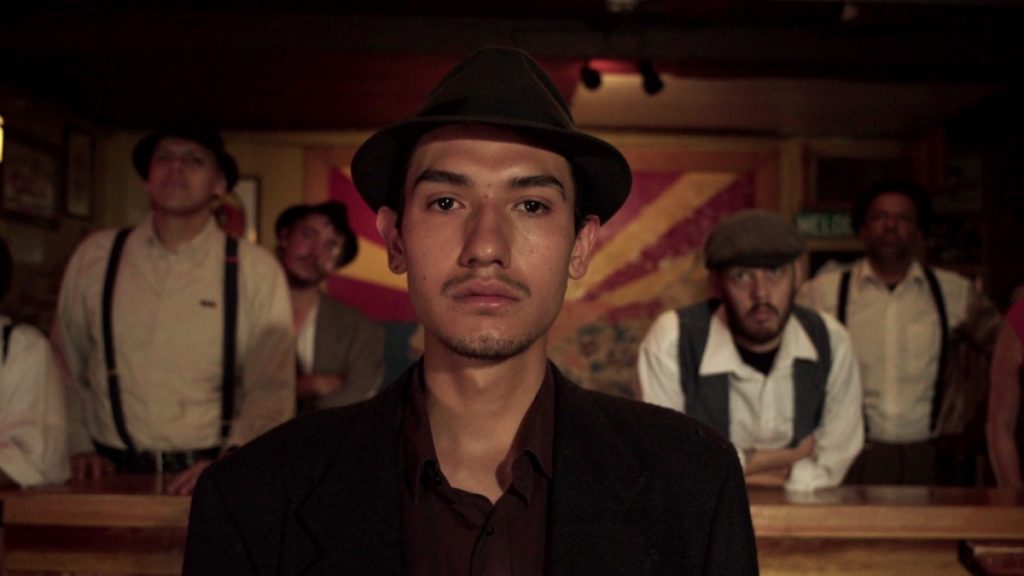
Bisbee, Arizona, was one of the largest copper mining centers in America until it became a virtual ghost town in 1975 when its two massive mines were closed. Forty years later, Bisbee is a community of eccentrics, immigrants, hippies, bikers and drifters, attempting to reckon with a dark and violent history of a forgotten event known as the Bisbee Deportation.
Bisbee ’17 documents locals as they play characters and stage dramatic scenes from the controversial story, culminating in a largescale recreation of the deportation itself on the exact day of its 100th anniversary.
Directed by Robert Greene, Bisbee ’17 has its national broadcast debut on the PBS documentary series POV and pov.org on Monday, July 15 at 10 p.m. (check local listings). POV is American television’s longest-running independent documentary series now in its 32nd season.
A town perpetually on the brink, Bisbee is near the border of Mexico and home to a politically leftist history. Whereas nearby Tombstone is the birthplace of the anti-immigrant Minutemen, Bisbee is more inclusive, even if many residents of the poorer surrounding communities consider the touristy “Old Bisbee” too gentrified. It’s a desert Twin Peaks, full of strange stories and peculiar mythologies. The two massive holes in the earth and semi-toxic manmade mountain serve as constant reminders of the town’s violent mining past.
On July 12, 1917, nearly 2,000 striking miners, many of whom were immigrants who had aligned with the radical IWW union, were violently extracted from their homes by a white-arm-banded force organized by the sheriff and the large mining corporations, including Phelps Dodge. The U.S. had just entered World War I, and rumors were swirling that these strikers were conspiring with the Germans and Mexican revolutionaries to blow up buildings in town and hamper the war effort. Echoing other moments in our nation’s history, fear and paranoia were used to motivate and organize a group of strikebreakers.
The miners were rounded up, led by gunpoint to the Warren baseball field, forced onto cattle cars and dropped in the middle of the barren New Mexican desert. They were left at an Army camp and never allowed to return to town. Many were lost to history. This malicious and largely forgotten act hastened the end of unions in Arizona, which today is a right-to-work state. One hundred years later, unspoken tensions hang in a town where many residents are descendants of miners and just as many are relatives of the company owners. As historian and Bisbee native Charles Bethea says, “The Deportation caused a wound that has never healed.” As the centennial anniversary of the deportation nears, the town begins to reckon with this still-divisive past by staging western or musical-style recreations in many of the places where the events in the story actually took place.
Bisbee residents bring their own personal histories to the fore: Sue Ray has long wanted to tell the story of her grandfather deporting his own brother, which lead to them never speaking again. Elsewhere in town, Annie disagrees strongly with her father (a man who became president of the mining company and sees the deportation as justifiable and even patriotic). Laurie is a local artist playing out her fantasies onscreen as a male IWW striker, while Mike is the keeper of the ballfield with complex views on who must choose which side to take. Meanwhile, Fernando, a 23-year-old gay Mexican-American whose mother was deported and jailed for immigration and drug charges, is experiencing a political awakening because he’s chosen to play the role of a Mexican miner.
These stories, told with a mix of documentary and dramatization, build up to a largescale attempt to recreate the deportation itself. What happens when all these personal stories and perspectives converge? The challenges of wrangling and narrativizing this moment highlight the multilayered and often-conflicting way history gets retold and myths get made. Who gets to tell the stories of the past? Who is responsible when the ghosts return?
“Bisbee ’17 is a vivid exploration of the documentary form, expanding on the possibilities of nonfiction storytelling with a powerful reclamation of personal and collective history,” said Justine Nagan, executive producer for POV. “More than a century later, Bisbee’s violent past echoes in today’s fight over of immigration and labor rights. As one town grapples with its past, Bisbee ’17 asks a national audience what other histories across the country are waiting to be re-told?”
Robert Greene, Director/Editor
Robert Greene’s latest award-winning film Bisbee ’17 premiered at the 2018 Sundance Film Festival. His previous film Kate Plays Christine won a Jury Award for Writing at Sundance 2016. Robert’s documentaries include the Gotham Awards-nominated Actress, Fake It So Real and the Gotham Awards-nominated Kati With An I. Robert was an inaugural Sundance Art of Nonfiction fellow in 2015 and is a three-time nominee for Best Director at the Cinema Eye Honors. The Independent named Robert one of their 10 Filmmakers to Watch in 2014 and he received the 2014 Vanguard Artist Award from the San Francisco DocFest. His first documentary, Owning The Weather, was screened at the COP15 Climate Change Conference in Copenhagen. Robert has edited over a dozen features, including Her Smell (2018), Golden Exits (2017), Queen of Earth (2015) and Listen Up Philip (2014) by Alex Ross Perry, Amanda Rose Wilder’s award winning Approaching The Elephant (2014), Charles Poekel’s Spirit Awards-nominated Christmas, Again (2015) and Douglas Tirola’s Hey Bartender (2013). He has been a Sundance Edit Lab Advisor and was on the U.S. Documentary Jury for Sundance 2017. Robert writes for outlets such as Sight & Sound and serves as the Filmmaker-in-Chief for the Murray Center for Documentary Journalism at the University of Missouri.

Leave a Reply
You must be logged in to post a comment.